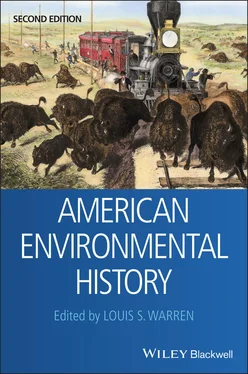The extent, frequency, and impact of Indian burning is not without controversy. Raup (1937) argued that climatic change rather than Indian burning could account for certain vegetation changes. Emily Russell (1983), assessing pre-1700 information for the Northeast, concluded that: “There is no strong evidence that Indians purposely burned large areas,” but Indians did “increase the frequency of fires above the low numbers caused by lightning,” creating an open forest. But then Russell adds: “In most areas climate and soil probably played the major role in determining the precolonial forests.” She regards Indian fires as mainly accidental and “merely” augmental to natural fires, and she discounts the reliability of many early accounts of burning.
Forman and Russell (1983, 5) expand the argument to North America in general: “regular and widespread Indian burning (Day 1953) [is] an unlikely hypothesis that regretfully has been accepted in the popular literature and consciousness.” This conclusion, I believe, is unwarranted given reports of the extent of prehistoric human burning in North America and Australia (Lewis 1982), and Europe (Patterson and Sassaman 1988, 130), and by my own and other observations on current Indian and peasant burning in Central America and South America; when unrestrained, people burn frequently and for many reasons. For the Northeast, Patterson and Sassaman (1988, 129) found that sedimentary charcoal accumulations were greatest where Indian populations were greatest.
Elsewhere in North America, the Southeast is much more fire prone than is the Northeast, with human ignitions being especially important in winter (Taylor 1981). The Berkeley geographer and Indianist Erhard Rostlund (1957, 1960) argued that Indian clearing and burning created many grasslands within mostly open forest in the so-called “prairie belt” of Alabama. As improbable as it may seem, Lewis (1982) found Indian burning in the subarctic, and Dobyns (1981) in the Sonoran desert. The characteristics and impacts of fires set by Indians varied regionally and locally with demography, resource management techniques, and environment, but such fires clearly had different vegetation impacts than did natural fires owing to differences in frequency, regularity, and seasonality.
In North America, burning not only maintained open forest and small meadows but also encouraged fire-tolerant and sun-loving species. “Fire created conditions favorable to strawberries, blackberries, raspberries, and other gatherable foods” (Cronon 1983, 51). Other useful plants were saved, protected, planted, and transplanted, such as American chestnut, Canada plum, Kentucky coffee tree, groundnut, and leek (Day 1953, 339–40). Gilmore (1931) described the dispersal of several native plants by Indians. Mixed stands were converted to single species dominants, including various pines and oaks, sequoia, Douglas fir, spruce, and aspen (M. Williams 1989a, 47–48). The longleaf, slash pine, and scrub oak forests of the Southeast are almost certainly an anthropogenic subclimax created originally by Indian burning, replaced in early Colonial times by mixed hardwoods, and maintained in part by fires set by subsequent farmers and woodlot owners (Garren 1943). Lightning fires can account for some fire-climax vegetation, but Indian burning would have extended and maintained such vegetation (Silver 1990, 17–19, 59–64).
Even in the humid tropics, where natural fires are rare, human fires can dramatically influence forest composition. A good example is the pine forests of Nicaragua (Denevan 1961). Open pine stands occur both in the northern highlands (below 5,000 feet) and in the eastern (Miskito) lowlands, where warm temperatures and heavy rainfall generally favor mixed tropical montane forest or rain forest. The extensive pine forests of Guatemala and Mexico primarily grow in cooler and drier, higher elevations, where they are in large part natural and prehuman (Watts and Bradbury 1982, 59). Pine forests were definitely present in Nicaragua when Europeans arrived. They were found in areas where Indian settlement was substantial, but not in the eastern mountains where Indian densities were sparse. The eastern boundary of the highland pines seems to have moved with an eastern settlement frontier that has fluctuated back and forth since prehistory. The pines occur today where there has been clearing followed by regular burning and the same is likely in the past. The Nicaraguan pines are fire tolerant once mature, and large numbers of seedlings survive to maturity if they can escape fire during their first three to seven years (Denevan 1961, 280). Where settlement has been abandoned and fire ceases, mixed hardwoods gradually replace pines. This succession is likely similar where pines occur else-where at low elevations in tropical Central America, the Caribbean, and Mexico.
Midwest Prairies and Tropical Savannas
Sauer (1950, 1958, 1975) argued early and often that the great grass-lands and savannas of the New World were of anthropogenic rather than climatic origin, that rainfall was generally sufficient to support trees. Even nonagricultural Indians expanded what may have been pockets of natural, edaphic grasslands at the expense of forest. A fire burning to the edge of a grass/forest boundary will penetrate the drier forest margin and push back the edge, even if the forest itself is not consumed (Mueller-Dombois 1981, 164). Grassland can therefore advance significantly in the wake of hundreds of years of annual fires. Lightning-set fires can have a similar impact, but more slowly if less frequent than human fires, as in the wet tropics.
… Most ecologists now believe that the eastern prairies “would have mostly disappeared if it had not been for the nearly annual burning of these grasslands by the North American Indians,” during the last 5,000 years. A case in point is the nineteenth-century invasion of many grasslands by forests after fire had been suppressed in Wisconsin, Illinois, Kansas, Nebraska, and elsewhere (M. Williams 1989a, 46).
The large savannas of South America are also controversial as to origin. Much, if not most of the open vegetation of the Orinoco Llanos, the Llanos de Mojos of Bolivia, the Pantanal of Mato Grosso, the Bolívar savannas of Colombia, the Guayas savannas of coastal Ecuador, the campo cerrado of central Brazil, and the coastal savannas north of the Amazon, is of natural origin. The vast campos cerrados occupy extremely senile, often toxic oxisols. The seasonally inundated savannas of Bolivia, Brazil, Guayas, and the Orinoco owe their existence to the intolerance of woody species to the extreme alternation of lengthy flooding or water-logging and severe desiccation during a long dry season. These savannas, however, were and are burned by Indians and ranchers, and such fires have expanded the savannas into the forests to an unknown extent. It is now very difficult to determine where a natural forest/savanna boundary once was located (Hills and Randall 1968; Medina 1980).
Other small savannas have been cut out of the rainforest by Indian farmers and then maintained by burning. An example is the Gran Pajonal in the Andean foothills in east-central Peru, where dozens of small grasslands ( pajonales ) have been created by Campa Indians – a process clearly documented by air photos (Scott 1978). Pajonales were in existence when the region was first penetrated by Franciscan missionary explorers in 1733.
The impact of human activity is nicely illustrated by vegetational changes in the basins of the San Jorge, Cauca, and Sinú rivers of northern Colombia. The southern sector, which was mainly savanna when first observed in the sixteenth century, had reverted to rainforest by about 1750 following Indian decline, and had been reconverted to savanna for pasture by 1950 (Gordon 1957, map p. 69). Sauer (1966, 285–88; 1975, 8) and Bennett (1968, 53–55) cite early descriptions of numerous savannas in Panama in the sixteenth century. Balboa’s first view of the Pacific was from a “treeless ridge,” now probably forested. Indian settlement and agricultural fields were common at the time, and with their decline the rainforest returned.
Читать дальше











